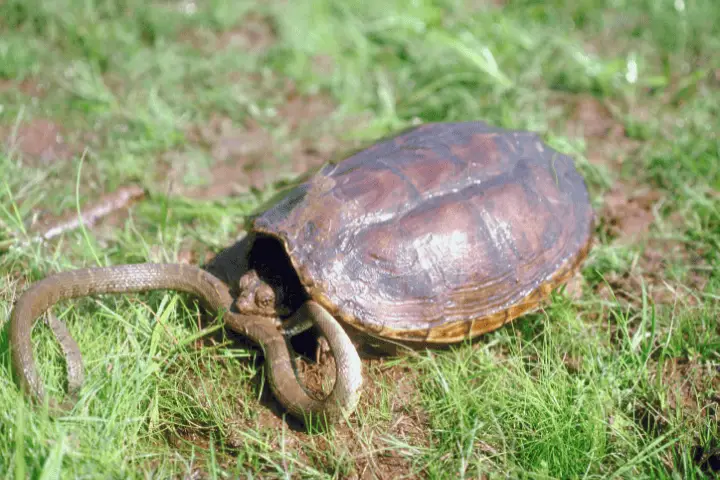Do Turtles Eat Snakes
Turtles may not seem like predators, but do they eat snakes? It turns out some species do!
Snapping turtles have been seen devouring small snakes with their sharp-edged jaws. Box turtles have also been known to consume young snakes.
Although it may vary by habitat and species, it’s clear there’s more than meets the eye when it comes to turtles and snakes.
Understanding Turtles’ Diet
Turtles have diverse diets, depending on their species and habitat. They eat plants, insects, fish, and even small mammals.
Let’s take a look at some common turtle species and their favorite foods:
- Green Turtle – Seagrass and algae.
- Box Turtle – Fruits, vegetables, and insects.
- Snapping Turtle – Fish, frogs, snakes, and plants.
These are just a few examples of turtle diets. Every species has its own preferences, based on biology and environment.
It’s interesting to see how turtles adapt to what’s available in their habitats.
Do turtles eat snakes? It depends on the species. Snapping turtles tend to be carnivorous, so they have been seen eating snakes.
But, an individual turtle’s diet can depend on its age and prey availability.
Do Turtles Eat Snakes?
Turtles are known for their diverse eating habits, but do they consume snakes?
- Turtles are opportunistic eaters: These creatures have a varied diet that includes plants, insects, fish, and small animals. However, while turtles may occasionally consume snakes, it is not a common occurrence.
- Size matters: The size and species of the turtle play a crucial role in their dietary preferences. Smaller turtles are more likely to feed on insects and plants, while larger turtles can consume small snakes if given the opportunity.
- Specific turtle species: Some turtle species, such as the alligator snapping turtle, are known to actively hunt and consume snakes. However, this behavior is not exhibited by all turtle species.
- Other factors: The availability of prey, habitat, and natural instincts also influence a turtle’s diet. This means that even if turtles have the capacity to eat snakes, their actual consumption may vary due to environmental factors.
It’s interesting to note that while turtles can eat snakes, it is not a defining trait of their diet.
Therefore, it is essential to consider various factors before assuming that turtles regularly consume snakes.
Types of Turtles that Eat Snakes
Turtles have amazing diets, and some even eat snakes! Here’s a list of turtles that consume snakes:
- Snapping Turtles
- Softshell Turtles
- Musk Turtles
- Painted Turtles
- Box Turtles
Snapping Turtles have strong jaws to overpower snakes. Softshell Turtles have webbed feet to catch snakes quickly in water.
Musk Turtles have sharp beaks to eat baby snakes.
Painted Turtles use their sharp beaks to grab snakes in their habitat. Box Turtles take advantage of small snake species.
We know from history that turtles have been known to hunt and eat snakes. Scientists continue to study these interactions to learn more about the relationship between the two species.
By understanding the types of turtles that eat snakes, we can appreciate their adaptability and diet.
Why Turtles Eat Snakes
Turtles are known for their diverse diet, which includes snakes! This behavior is attributed to their opportunistic nature.
They are omnivorous, meaning they eat plants and animals. Their primary food consists of aquatic plants and fruits.
But, they also eat small invertebrates such as worms, insects, and snakes.
Their powerful jaws and sharp beaks enable them to catch prey. It’s amazing how they can capture even the most agile snakes.
Turtles hide among vegetation or rocks before ambushing their prey.
Snakes provide turtles with proteins and essential nutrients. Eating snakes also helps control their population in certain ecosystems.
Not all turtle species have the capability or preference to eat snakes. However, some species have been observed doing this in the wild.
An example of this is the common snapping turtle (Chelydra serpentina).
It is well-known for its ability to eat snakes with ease.
The Importance of Snakes in Turtles’ Diet
Unveiling the Significance of Snakes in the Dietary Habits of Turtles
Snakes assume a crucial role in the diet of turtles, playing a vital part in their nutritional intake. By consuming snakes, turtles acquire essential nutrients and maintain a balanced diet.
These reptiles rely on the presence of snakes to fulfill their dietary requirements efficiently.
Furthermore, snakes provide turtles with a diverse range of benefits. The consumption of snakes contributes to the overall fitness and well-being of turtles, enabling them to thrive in their natural habitats.
By consuming snakes as part of their diet, turtles harness the nutritional value and adaptability that these reptiles offer.
In addition to the nutritional aspect, the inclusion of snakes in turtles’ diets also supports the balance and stability of ecosystems.
Snakes can regulate the population of certain prey species, preventing overpopulation that could disrupt the delicate equilibrium of the environment.
This ecological aspect further highlights the importance of snakes in maintaining the overall health of turtle populations.
Nutritional Benefits of Snakes for Turtles
Snakes offer essential nutrients to turtles, boosting their health and well-being. These include proteins, vitamins, and minerals – all essential for the growth and development of turtles.
Moreover, snakes provide unique nutrients not found in other prey items. For example, some snake species are high in omega-3 fatty acids, which are important for brain and heart health.
Varying a turtle’s diet with snake meat or whole snakes is recommended. When doing so, safety precautions should be taken.
This includes using species-appropriate prey, removing venomous glands, and avoiding those that may carry parasites or diseases.
By including snakes in turtle diets, we can supply them with essential nutrients and help ensure their longevity.
It is recommended to consult a reptile vet or an expert on turtle care to make sure the turtle’s dietary needs are met.
Snakes as a Source of Enrichment for Turtles
Snakes form an essential part of a turtle’s diet. They provide various advantages that support the overall health and growth of turtles.
- Snakes arouse natural hunting habits in turtles, motivating them to actively seek food. This helps to keep turtles mentally engaged and stops boredom.
- Interacting with snakes also beefs up a turtle’s physical fitness. Catching and consuming snakes necessitates agility and strength, thus promoting exercise and keeping their bodies active.
- The presence of snakes in a turtle’s diet introduces variety. This ensures they get a balanced nutrition, with nutrients not found in other prey items.
- Moreover, snakes offer a challenge to turtles while they feed. Their movement patterns and defensive strategies force turtles to adjust their hunting techniques, improving their problem-solving skills.
It is important to note that not all snake species are fit for a turtle’s diet. Some snakes may contain toxins or parasites that can harm the turtle.
So, owners or caretakers must research which snake species are safe for turtles before introducing them in their diet.
To guarantee the safety and efficiency of using snakes as enrichment for turtles, we suggest:
- Offer pre-killed or frozen-thawed snakes: This lowers the danger of injuries to both the turtle and the keeper, while still providing the benefits of interacting with snakes.
- Vary snake sizes: Offering different sizes of snakes tests the turtle’s capacity to catch and consume prey, encouraging mental stimulation and dexterity.
- Rotate snake feedings: Alternating between feeding sessions with snakes and other prey items avoids reliance on one form of food source, ensuring a balanced diet.
By following these tips, owners can improve their turtle’s well-being by utilizing snakes as a source of enrichment in their diet.
Snakes not only provide physical and mental challenges, but they also add to the overall health and development of turtles.

